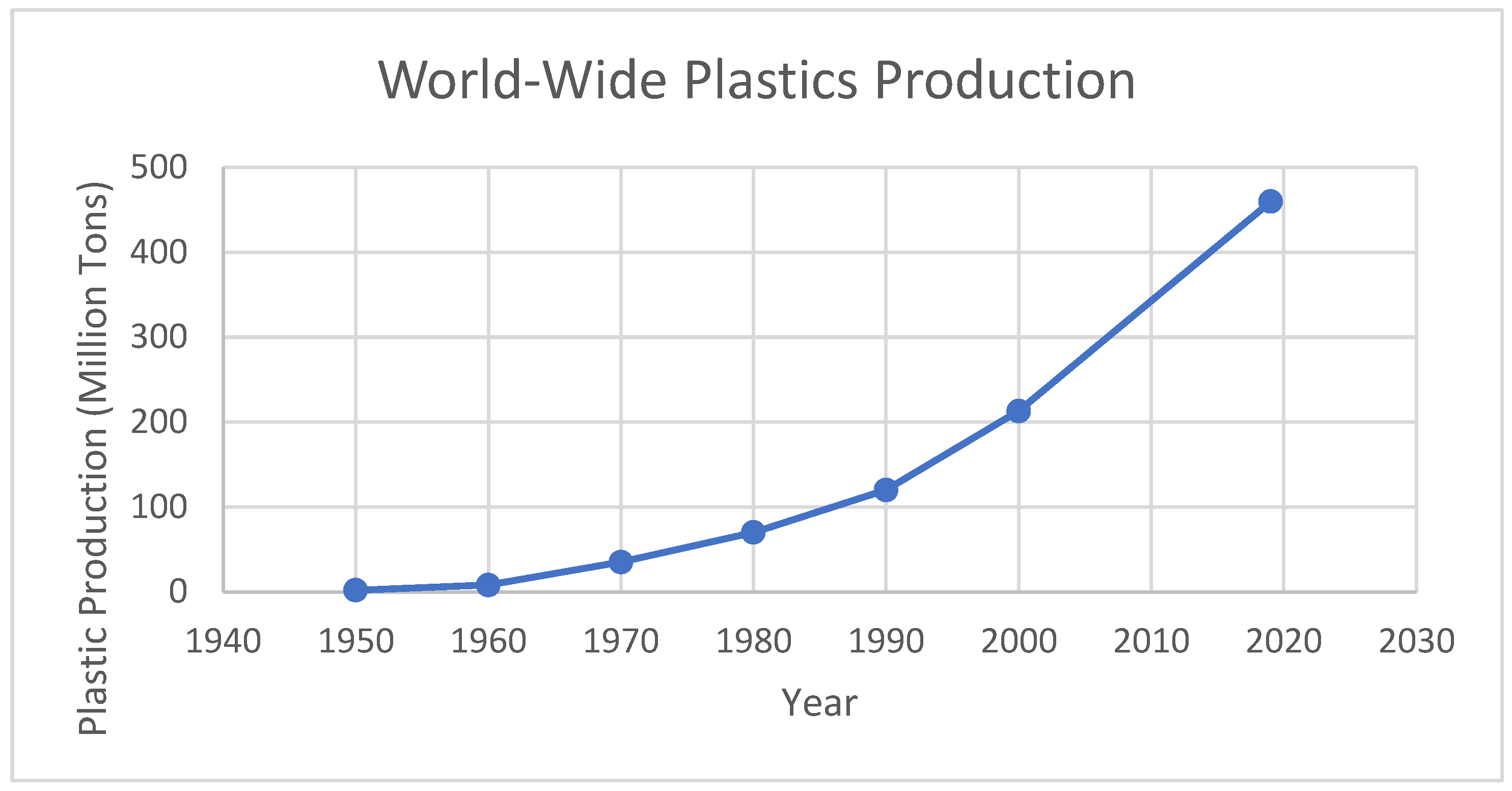Would the Oceans Become Toxic to Humanity Due to Use and Mismanagement of Plastics?
Abstract
1. Introduction and Background
1.1. Plastic Generation and Consumption
1.2. Where Do MPs End Up?
1.3. The Global Perspective on MPs
2. Literature Survey
2.1. Effects of Metals with MPs
2.2. Effects of Organic Contaminants with MPs
3. Ways to Eliminate MPs in Oceans
3.1. Model Overview
- year of input into the ocean;
- specific year of plastic production;
- annual mass fraction of discarded plastic reaching costal ocean;
- global plastic mass produced;
- annual mass fraction of stranded or settled macroplastics that is released back into surface waters of coastal environments;
- annual mass fraction of settled or stranded macroplastics degrading into MPs;
- macroplastic material in the shoreline;
- annual mass fraction of floating macroplastics degrading into MPs;
- macroplastic material remaining from the previous year.
- annual mass fraction of floating plastic that strands and settles around shorelines;
- annual mass fraction of remaining floating plastic that is transported offshore.
3.2. Model Assumptions
3.3. Discussion and Interpretation of the Model Proposed by Lebreton et al.
4. Plastic Toxicity
4.1. Effects of MPS on Humans
4.2. MPs Effects on Marine Life
4.3. A Toxicity Value for the Oceans
- By utilizing the model proposed by Lebreton et al., 2019 [6] and with the plastics discharge growth rate continuing at that of the 2005–2015 period (Equation (6)), the mass can be by either the year 2398 or 2456.
- Similarly, by utilizing the model proposed by Lebreton et al., 2019 [6] and with a plastics discharge rate in 2020 (Equation (7)), the mass can be reached by either the year 2408 or 2472.
- For plastic discharges stopping in 2020, the extrapolation extends to many millennia in the future, certainly beyond any validity. This indicates that the only safe strategy given the current knowledge is to attempt to completely eliminate plastic emissions into the ocean. This is especially worth considering, as the mass of small microplastics is unknown and is known to be far more toxic [48].
- The above analysis made many assumptions and should be only considered to warn humanity to take collective action to remediate the problem of microplastic contamination.
5. Remediation Strategies
- Education and awareness;
- Reduce the utilization of single-use plastic;
- Conventional and innovative strategies for microplastic concentration, treatment, and destruction [53].
5.1. Education and Awareness
5.2. Reduce Use of Single-Use Plastic
5.3. Conventional and Innovative Strategies for Microplastic Treatment and Destruction
5.4. Advanced Technologies for Plastic Waste Disposal
6. Summary and Conclusions
Author Contributions
Funding
Institutional Review Board Statement
Informed Consent Statement
Data Availability Statement
Acknowledgments
Conflicts of Interest
References
- Sping, M.; Donohue, M.; Gierach, M.; Jambeck, J.; Kite-Powell, H.L.; Law, K.L.; Lund, J.; Narayan, R.; Schwartz, E.; Sumaila, R.; et al. Reckoning with the U.S. Role in Global Ocean Plastic Waste; National Academies Press: Washington, DC, USA, 2022. [Google Scholar] [CrossRef]
- OECD. Global Plastics Outlook: Economic Drivers, Environmental Impacts and Policy Options; Organisation for Economic Co-Operation and Development: Paris, France, 2022; Available online: https://www.oecd-ilibrary.org/environment/global-plastics-outlook_de747aef-en (accessed on 5 June 2024).
- Geyer, R.; Jambeck, J.R.; Law, K.L. Production, use, and fate of all plastics ever made. Sci. Adv. 2017, 3, e1700782. [Google Scholar] [CrossRef] [PubMed]
- World Economic Forum. The New Plastics Economy: Rethinking the Future of Plastics; World Economic Forum: Cologny, Switzerland, 2016; Available online: https://www.weforum.org/publications/the-new-plastics-economy-rethinking-the-future-of-plastics/ (accessed on 5 June 2024).
- OECD. Global Plastics Outlook: Policy Scenarios to 2060; Organisation for Economic Co-Operation and Development: Paris, France, 2022; Available online: https://www.oecd-ilibrary.org/environment/global-plastics-outlook_aa1edf33-en (accessed on 5 June 2024).
- Lebreton, L.; Egger, M.; Slat, B. A global mass budget for positively buoyant macroplastic debris in the ocean. Sci. Rep. 2019, 9, 12922. [Google Scholar] [CrossRef]
- Babaremu, K.O.; Okoya, S.A.; Hughes, E.; Tijani, B.; Teidi, D.; Akpan, A.; Igwe, J.; Karera, S.; Oyinlola, M.; Akinlabi, E.T. Sustainable plastic waste management in a circular economy. Heliyon 2022, 8, e09984. [Google Scholar] [CrossRef]
- Eriksen, M.; Cowger, W.; Erdle, L.M.; Coffin, S.; Villarrubia-Gómez, P.; Moore, C.J.; Carpenter, E.J.; Day, R.H.; Thiel, M.; Wilcox, C. A growing plastic smog, now estimated to be over 170 trillion plastic particles afloat in the world’s oceans—Urgent solutions required. PLoS ONE 2023, 18, e0281596. [Google Scholar] [CrossRef] [PubMed]
- Gasperi, J.; Wright, S.L.; Dris, R.; Collard, F.; Mandin, C.; Guerrouache, M.; Langlois, V.; Kelly, F.J.; Tassin, B. Microplastics in air: Are we breathing it in? Curr. Opin. Environ. Sci. Health 2018, 1, 1–5. [Google Scholar] [CrossRef]
- Yang, N.; Zhang, H.; Chen, M.; Shao, L.-M.; He, P.-J. Greenhouse gas emissions from MSW incineration in China: Impacts of waste characteristics and energy recovery. Waste Manag. 2012, 32, 2552–2560. [Google Scholar] [CrossRef] [PubMed]
- Velis, C.A.; Cook, E. Mismanagement of Plastic Waste through Open Burning with Emphasis on the Global South: A Systematic Review of Risks to Occupational and Public Health. Environ. Sci. Technol. 2021, 55, 7186–7207. [Google Scholar] [CrossRef] [PubMed]
- Barrows, A.P.W.; Cathey, S.E.; Petersen, C.W. Marine environment microfiber contamination: Global patterns and the diversity of microparticle origins. Environ. Pollut. 2018, 237, 275–284. [Google Scholar] [CrossRef] [PubMed]
- Sutkar, P.R.; Gadewar, R.D.; Dhulap, V.P. Recent trends in degradation of microplastics in the environment: A state-of-the-art review. J. Hazard. Mater. Adv. 2023, 11, 100343. [Google Scholar] [CrossRef]
- Hidalgo-Ruz, V.; Gutow, L.; Thompson, R.C.; Thiel, M. Microplastics in the Marine Environment: A Review of the Methods Used for Identification and Quantification. Environ. Sci. Technol. 2012, 46, 3060–3075. [Google Scholar] [CrossRef] [PubMed]
- Surana, M.; Pattanayak, D.S.; Yadav, V.; Singh, V.K.; Pal, D. An insight decipher on photocatalytic degradation of microplastics: Mechanism, limitations, and future outlook. Environ. Res. 2024, 247, 118268. [Google Scholar] [CrossRef] [PubMed]
- Koelmans, A.A.; Mohamed Nor, N.H.; Hermsen, E.; Kooi, M.; Mintenig, S.M.; De France, J. Microplastics in freshwaters and drinking water: Critical review and assessment of data quality. Water Res. 2019, 155, 410–422. [Google Scholar] [CrossRef]
- Pradit, S.; Puttapreecha, R.; Noppradit, P.; Buranapratheprat, A.; Sompongchaiyakul, P. The first evidence of microplastic presence in pumice stone along the coast of Thailand: A preliminary study. Front. Mar. Sci. 2022, 9, 961729. [Google Scholar] [CrossRef]
- Grande-Tovar, C.D.; Carrascal-Hernández, D.C.; Trilleras, J.; Mora, K.; Arana, V.A. Microplastics’ and Nanoplastics’ Interactions with Microorganisms: A Bibliometric Study. Sustainability 2022, 14, 14761. [Google Scholar] [CrossRef]
- Abihssira-García, I.S.; Park, Y.; Kiron, V.; Olsvik, P.A. Fluorescent Microplastic Uptake by Immune Cells of Atlantic Salmon (Salmo salar L.). Front. Environ. Sci. 2020, 8, 560206. [Google Scholar] [CrossRef]
- de Souza Machado, A.A.; Lau, C.W.; Till, J.; Kloas, W.; Lehmann, A.; Becker, R.; Rillig, M.C. Impacts of Microplastics on the Soil Biophysical Environment. Environ. Sci. Technol. 2018, 52, 9656–9665. [Google Scholar] [CrossRef] [PubMed]
- Chen, Q.; Zhao, H.; Liu, Y.; Jin, L.; Peng, R. Factors Affecting the Adsorption of Heavy Metals by Microplastics and Their Toxic Effects on Fish. Toxics 2023, 11, 490. [Google Scholar] [CrossRef]
- da Silva, J.M.; Alves, L.M.F.; Laranjeiro, M.I.; Bessa, F.; Silva, A.V.; Norte, A.C.; Lemos, M.F.L.; Ramos, J.A.; Novais, S.C.; Ceia, F.R. Accumulation of chemical elements and occurrence of microplastics in small pelagic fish from a neritic environment. Environ. Pollut. 2022, 292, 118451. [Google Scholar] [CrossRef] [PubMed]
- Devi, K.N.; Raju, P.; Santhanam, P.; Perumal, P. Impacts of microplastics on marine organisms: Present perspectives and the way forward. Egypt. J. Aquat. Res. 2022, 48, 205–209. [Google Scholar] [CrossRef]
- Esmaeilbeigi, M.; Kazemi, A.; Gholizadeh, M.; Rezaeiyeh, R.D. Microplastics and heavy metals contamination in Atropus atropos and associated health risk assessment in the northwest of the Persian Gulf, Iran. Reg. Stud. Mar. Sci. 2023, 57, 102750. [Google Scholar] [CrossRef]
- Jambeck, J.R.; Geyer, R.; Wilcox, C.; Siegler, T.R.; Perryman, M.; Andrady, A.; Narayan, R.; Law, K.L. Plastic waste inputs from land into the ocean. Science 2015, 347, 768–771. [Google Scholar] [CrossRef]
- Selvam, S.; Manisha, A.; Roy, P.D.; Venkatramanan, S.; Chung, S.Y.; Muthukumar, P.; Jesuraja, K.; Elgorban, A.M.; Ahmed, B.; Elzain, H.E. Microplastics and trace metals in fish species of the Gulf of Mannar (Indian Ocean) and evaluation of human health. Environ. Pollut. 2021, 291, 118089. [Google Scholar] [CrossRef] [PubMed]
- Zhou, G.; Wang, Q.; Li, J.; Li, Q.; Xu, H.; Ye, Q.; Wang, Y.; Shu, S.; Zhang, J. Removal of polystyrene and polyethylene microplastics using PAC and FeCl3 coagulation: Performance and mechanism. Sci. Total Environ. 2021, 752, 141837. [Google Scholar] [CrossRef] [PubMed]
- Pradit, S.; Noppradit, P.; Goh, B.P.; Sornplang, K.; Ong, M.C.; Towatana, P. Occurrence of Microplastics and Trace Metals in Fish and Shrimp from Songkhla Lake, Thailand During the COVID-19 Pandemic. Appl. Ecol. Environ. Res. 2021, 19, 1085–1106. [Google Scholar] [CrossRef]
- Vieira, K.S.; Baptista Neto, J.A.; Crapez, M.A.C.; Gaylarde, C.; Pierri, B.D.S.; Saldaña-Serrano, M.; Bainy, A.C.D.; Nogueira, D.J.; Fonseca, E.M. Occurrence of microplastics and heavy metals accumulation in native oysters Crassostrea Gasar in the Paranaguá estuarine system, Brazil. Mar. Pollut. Bull. 2021, 166, 112225. [Google Scholar] [CrossRef] [PubMed]
- Endo, S.; Takizawa, R.; Okuda, K.; Takada, H.; Chiba, K.; Kanehiro, H.; Ogi, H.; Yamashita, R.; Date, T. Concentration of polychlorinated biphenyls (PCBs) in beached resin pellets: Variability among individual particles and regional differences. Mar. Pollut. Bull. 2005, 50, 1103–1114. [Google Scholar] [CrossRef] [PubMed]
- Jiménez-Skrzypek, G.; Hernández-Sánchez, C.; Ortega-Zamora, C.; González-Sálamo, J.; González-Curbelo, M.Á.; Hernández-Borges, J. Microplastic-adsorbed organic contaminants: Analytical methods and occurrence. TrAC Trends Anal. Chem. 2021, 136, 116186. [Google Scholar] [CrossRef]
- Kinigopoulou, V.; Pashalidis, I.; Kalderis, D.; Anastopoulos, I. Microplastics as carriers of inorganic and organic contaminants in the environment: A review of recent progress. J. Mol. Liq. 2022, 350, 118580. [Google Scholar] [CrossRef]
- Law, K.L.; Morét-Ferguson, S.; Maximenko, N.A.; Proskurowski, G.; Peacock, E.E.; Hafner, J.; Reddy, C.M. Plastic Accumulation in the North Atlantic Subtropical Gyre. Science 2010, 329, 1185–1188. [Google Scholar] [CrossRef] [PubMed]
- Liu, J.; Hu, Z.; Du, F.; Tang, W.; Zheng, S.; Lu, S.; An, L.; Ding, J. Environment education: A first step in solving plastic pollution. Front. Environ. Sci. 2023, 11, 1130463. [Google Scholar] [CrossRef]
- Pletz, M. Ingested microplastics: Do humans eat one credit card per week? J. Hazard. Mater. Lett. 2022, 3, 100071. [Google Scholar] [CrossRef]
- Wang, F.; Gao, J.; Zhai, W.; Liu, D.; Zhou, Z.; Wang, P. The influence of polyethylene microplastics on pesticide residue and degradation in the aquatic environment. J. Hazard. Mater. 2020, 394, 122517. [Google Scholar] [CrossRef] [PubMed]
- Matias, R.S.; Gomes, S.; Barboza, L.G.A.; Almeida, C.M.R.; Marques, A.; Guilhermino, L.; Valente, L.M.P. Occurrence of microplastics and metals in European seabass produced in different aquaculture systems: Implications for human exposure, risk, and food safety. Sci. Total Environ. 2024, 929, 172535. [Google Scholar] [CrossRef] [PubMed]
- Wang, F.; Zhang, M.; Sha, W.; Wang, Y.; Hao, H.; Dou, Y.; Li, Y. Sorption Behavior and Mechanisms of Organic Contaminants to Nano and Microplastics. Molecules 2020, 25, 1827. [Google Scholar] [CrossRef]
- Hale, R.C.; Seeley, M.E.; La Guardia, M.J.; Mai, L.; Zeng, E.Y. A Global Perspective on Microplastics. J. Geophys. Res. Oceans 2020, 125, e2018JC014719. [Google Scholar] [CrossRef]
- Bailey, K.; Sipps, K.; Saba, G.K.; Arbuckle-Keil, G.; Chant, R.J.; Fahrenfeld, N.L. Quantification and composition of microplastics in the Raritan Hudson Estuary: Comparison to pathways of entry and implications for fate. Chemosphere 2021, 272, 129886. [Google Scholar] [CrossRef]
- Damaj, S.; Trad, F.; Goevert, D.; Wilkesmann, J. Bridging the Gaps between Microplastics and Human Health. Microplastics 2024, 3, 46–66. [Google Scholar] [CrossRef]
- Schofield, K. Weekend Reads|How Much Plastic Do We Ingest? South Seattle Emerald. Available online: https://southseattleemerald.com/2024/02/24/weekend-reads-how-much-plastic-do-we-ingest/ (accessed on 11 June 2024).
- Cox, K.D.; Covernton, G.A.; Davies, H.L.; Dower, J.F.; Juanes, F.; Dudas, S.E. Human Consumption of Microplastics. Environ. Sci. Technol. 2019, 53, 7068–7074. [Google Scholar] [CrossRef]
- Espinosa, C.; Esteban, M.Á.; Cuesta, A.; Espinosa, C.; Esteban, M.Á.; Cuesta, A. Microplastics in Aquatic Environments and Their Toxicological Implications for Fish. In Toxicology—New Aspects to This Scientific Conundrum; IntechOpen: London, UK, 2016. [Google Scholar] [CrossRef]
- Khanjani, M.H.; Sharifinia, M.; Mohammadi, A.R. The impact of microplastics on bivalve mollusks: A bibliometric and scientific review. Mar. Pollut. Bull. 2023, 194, 115271. [Google Scholar] [CrossRef]
- Expósito, N.; Rovira, J.; Sierra, J.; Gimenez, G.; Domingo, J.L.; Schuhmacher, M. Levels of microplastics and their characteristics in molluscs from North-West Mediterranean Sea: Human intake. Mar. Pollut. Bull. 2022, 181, 113843. [Google Scholar] [CrossRef] [PubMed]
- Ajith, N.; Arumugam, S.; Parthasarathy, S.; Manupoori, S.; Janakiraman, S. Global distribution of microplastics and its impact on marine environment—A review. Environ. Sci. Pollut. Res. 2020, 27, 25970–25986. [Google Scholar] [CrossRef]
- Beiras, R.; Schönemann, A.M. Currently monitored microplastics pose negligible ecological risk to the global ocean. Sci. Rep. 2020, 10, 22281. [Google Scholar] [CrossRef]
- Kvale, K.; Prowe, A.E.F.; Chien, C.-T.; Landolfi, A.; Oschlies, A. Zooplankton grazing of microplastic can accelerate global loss of ocean oxygen. Nat. Commun. 2021, 12, 2358. [Google Scholar] [CrossRef] [PubMed]
- Costello, M.J.; Cheung, A.; De Hauwere, N. Surface Area and the Seabed Area, Volume, Depth, Slope, and Topographic Variation for the World’s Seas, Oceans, and Countries. Environ. Sci. Technol. 2010, 44, 8821–8828. [Google Scholar] [CrossRef]
- Spellman, F.R. The Handbook of Nature; Rowman & Littlefield: Lanham, MD, USA, 2020. [Google Scholar]
- Water Basics|U.S. Geological Survey. USGS. Available online: https://www.usgs.gov/special-topics/water-science-school/science/water-basics (accessed on 17 December 2024).
- Meegoda, J.N.; Hettiarachchi, M.C. A Path to a Reduction in Micro and Nanoplastics Pollution. Int. J. Environ. Res. Public Health 2023, 20, 8. [Google Scholar] [CrossRef] [PubMed]
- Hettiarachchi, H.; Meegoda, J.N. Microplastic Pollution Prevention: The Need for Robust Policy Interventions to Close the Loopholes in Current Waste Management Practices. Int. J. Environ. Res. Public Health 2023, 20, 6434. [Google Scholar] [CrossRef] [PubMed]
- Gifford, R.; Nilsson, A. Personal and social factors that influence pro-environmental concern and behaviour: A review. Int. J. Psychol. 2014, 49, 141–157. [Google Scholar] [CrossRef] [PubMed]
- Vicente-Molina, M.A.; Fernández-Sáinz, A.; Izagirre-Olaizola, J. Environmental knowledge and other variables affecting pro-environmental behaviour: Comparison of university students from emerging and advanced countries. J. Clean. Prod. 2013, 61, 130–138. [Google Scholar] [CrossRef]
- Hammami, M.B.A.; Mohammed, E.Q.; Hashem, A.M.; Al-Khafaji, M.A.; Alqahtani, F.; Alzaabi, S.; Dash, N. Survey on awareness and attitudes of secondary school students regarding plastic pollution: Implications for environmental education and public health in Sharjah city, UAE. Environ. Sci. Pollut. Res. 2017, 24, 20626–20633. [Google Scholar] [CrossRef] [PubMed]
- Hartley, B.L.; Pahl, S.; Holland, M.; Alampei, I.; Veiga, J.M.; Thompson, R.C. Turning the tide on trash: Empowering European educators and school students to tackle marine litter. Mar. Policy 2018, 96, 227–234. [Google Scholar] [CrossRef]
- Lindwall, C. Single-Use Plastics 101. Available online: https://www.nrdc.org/stories/single-use-plastics-101 (accessed on 12 June 2024).
- Mandrikas, A.; Michailidi, E.; Stavrou, D. In-service Teachers’ Needs and Mentor’s Practices in Applying a Teaching–Learning Sequence on Nanotechnology and Plastics in Primary Education. J. Sci. Educ. Technol. 2021, 30, 630–641. [Google Scholar] [CrossRef]
- Miller, J.D.; Kim, H.; Kjeldsen, T.R.; Packman, J.; Grebby, S.; Dearden, R. Assessing the impact of urbanization on storm runoff in a peri-urban catchment using historical change in impervious cover. J. Hydrol. 2014, 515, 59–70. [Google Scholar] [CrossRef]
- Osman, A.I.; Hosny, M.; Eltaweil, A.S.; Omar, S.; Elgarahy, A.M.; Farghali, M.; Yap, P.-S.; Wu, Y.-S.; Nagandran, S.; Batumalaie, K.; et al. Microplastic sources, formation, toxicity and remediation: A review. Environ. Chem. Lett. 2023, 21, 2129–2169. [Google Scholar] [CrossRef] [PubMed]
- Padmaja, K.; Cherukuri, J.; Anji Reddy, M. A comparative study of the efficiency of chemical coagulation and electrocoagulation methods in the treatment of pharmaceutical effluent. J. Water Process Eng. 2020, 34, 101153. [Google Scholar] [CrossRef]
- Shirasaki, N.; Matsushita, T.; Matsui, Y.; Marubayashi, T. Effect of aluminum hydrolyte species on human enterovirus removal from water during the coagulation process. Chem. Eng. J. 2016, 284, 786–793. [Google Scholar] [CrossRef]
- Soares, J.; Miguel, I.; Venâncio, C.; Lopes, I.; Oliveira, M. On the path to minimize plastic pollution: The perceived importance of education and knowledge dissemination strategies. Mar. Pollut. Bull. 2021, 171, 112890. [Google Scholar] [CrossRef]
- Winters, J. Bans on Single-Use Plastic Bags Seem to Be Working. Mother Jones. Available online: https://www.motherjones.com/environment/2024/01/bans-single-use-plastic-bags/ (accessed on 10 April 2024).
- Chiba, S.; Saito, H.; Fletcher, R.; Yogi, T.; Kayo, M.; Miyagi, S.; Ogido, M.; Fujikura, K. Human footprint in the abyss: 30 year records of deep-sea plastic debris. Mar. Policy 2018, 96, 204–212. [Google Scholar] [CrossRef]
- Miller, A.; Jordan, M. Congress Introduces Bill to Ban Plastic Foam. Oceana USA. Available online: https://usa.oceana.org/press-releases/congress-introduces-bill-to-ban-plastic-foam/ (accessed on 10 April 2024).
- Kibria, M.G.; Masuk, N.I.; Safayet, R.; Nguyen, H.Q.; Mourshed, M. Plastic Waste: Challenges and Opportunities to Mitigate Pollution and Effective Management. Int. J. Environ. Res. 2023, 17, 20. [Google Scholar] [CrossRef]
- Fish, K.E.; Clarizia, L.; Meegoda, J. Microplastics in aquatic environments: A review of recent advances. J. Environ. Eng. Sci. 2023, 18, 138–156. [Google Scholar] [CrossRef]
- Okan, M.; Aydin, H.M.; Barsbay, M. Current approaches to waste polymer utilization and minimization: A review. J. Chem. Technol. Biotechnol. 2019, 94, 8–21. [Google Scholar] [CrossRef]
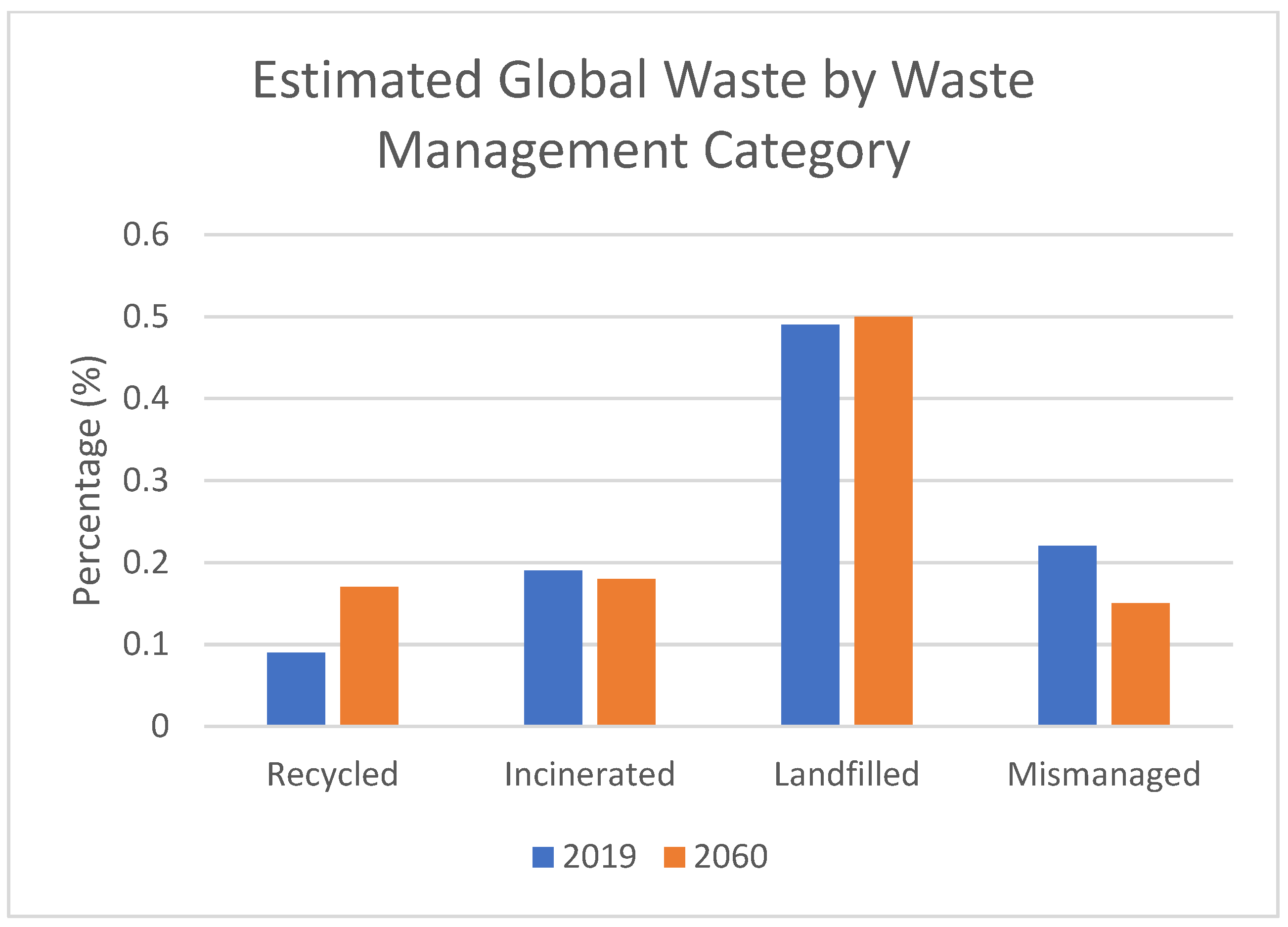

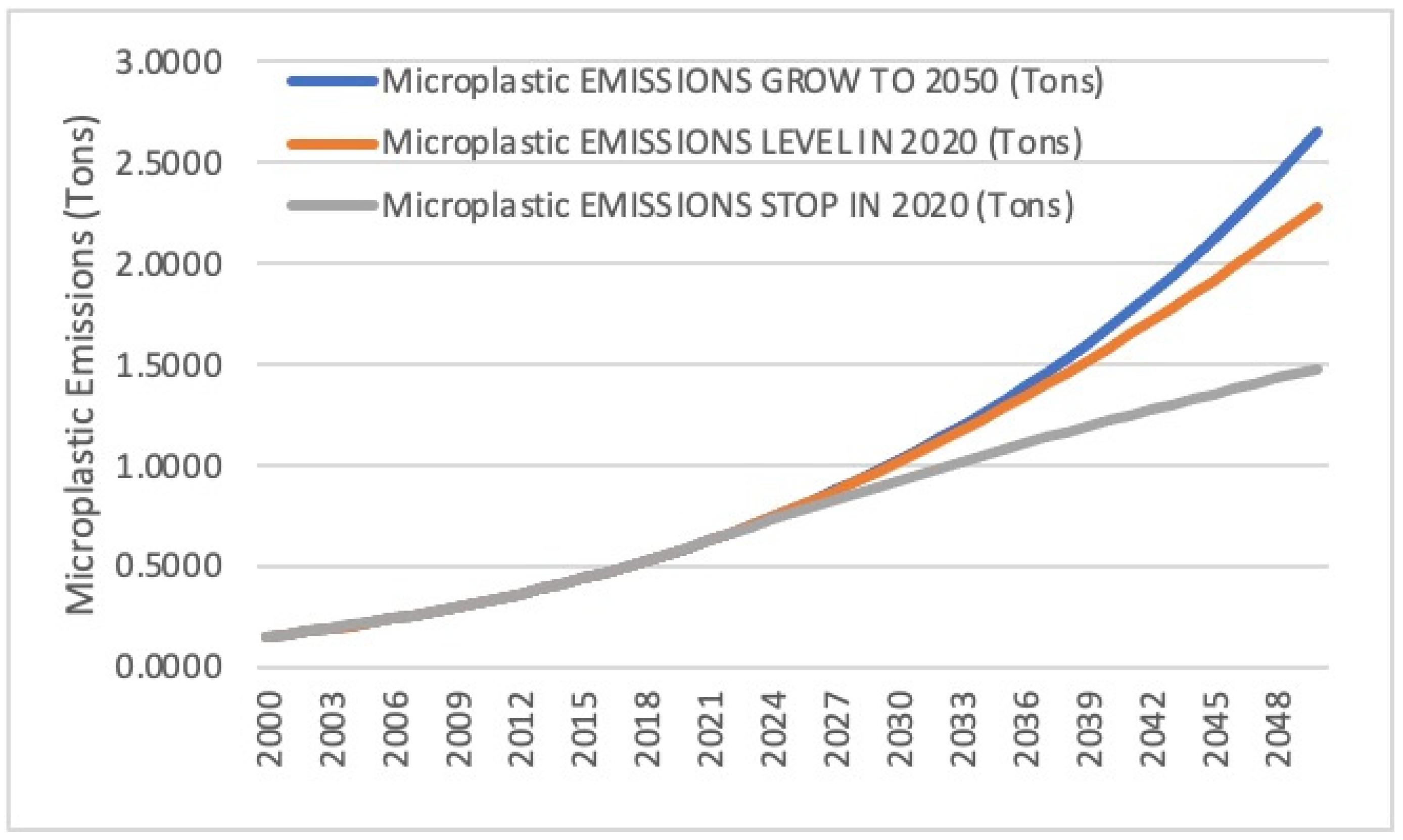
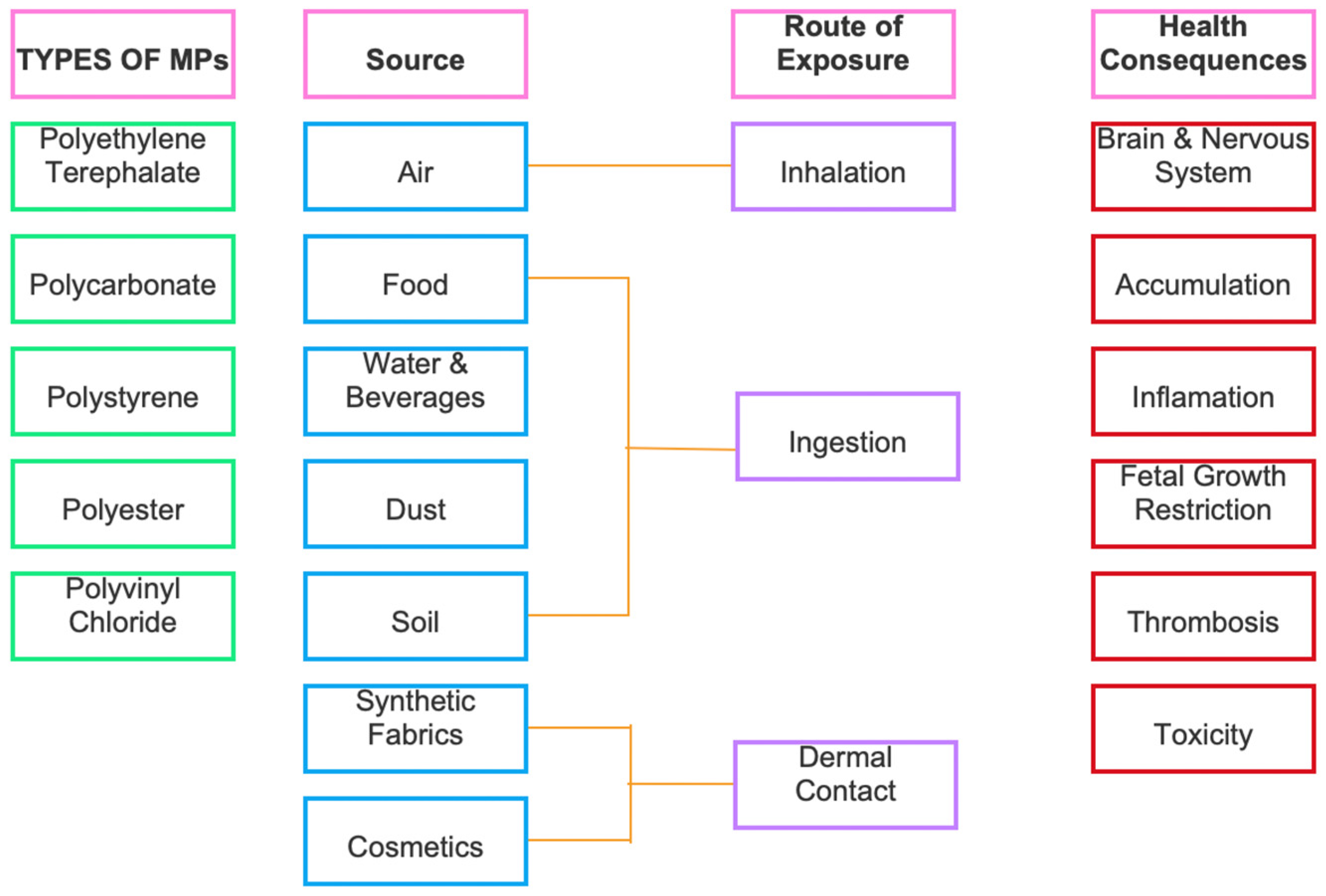
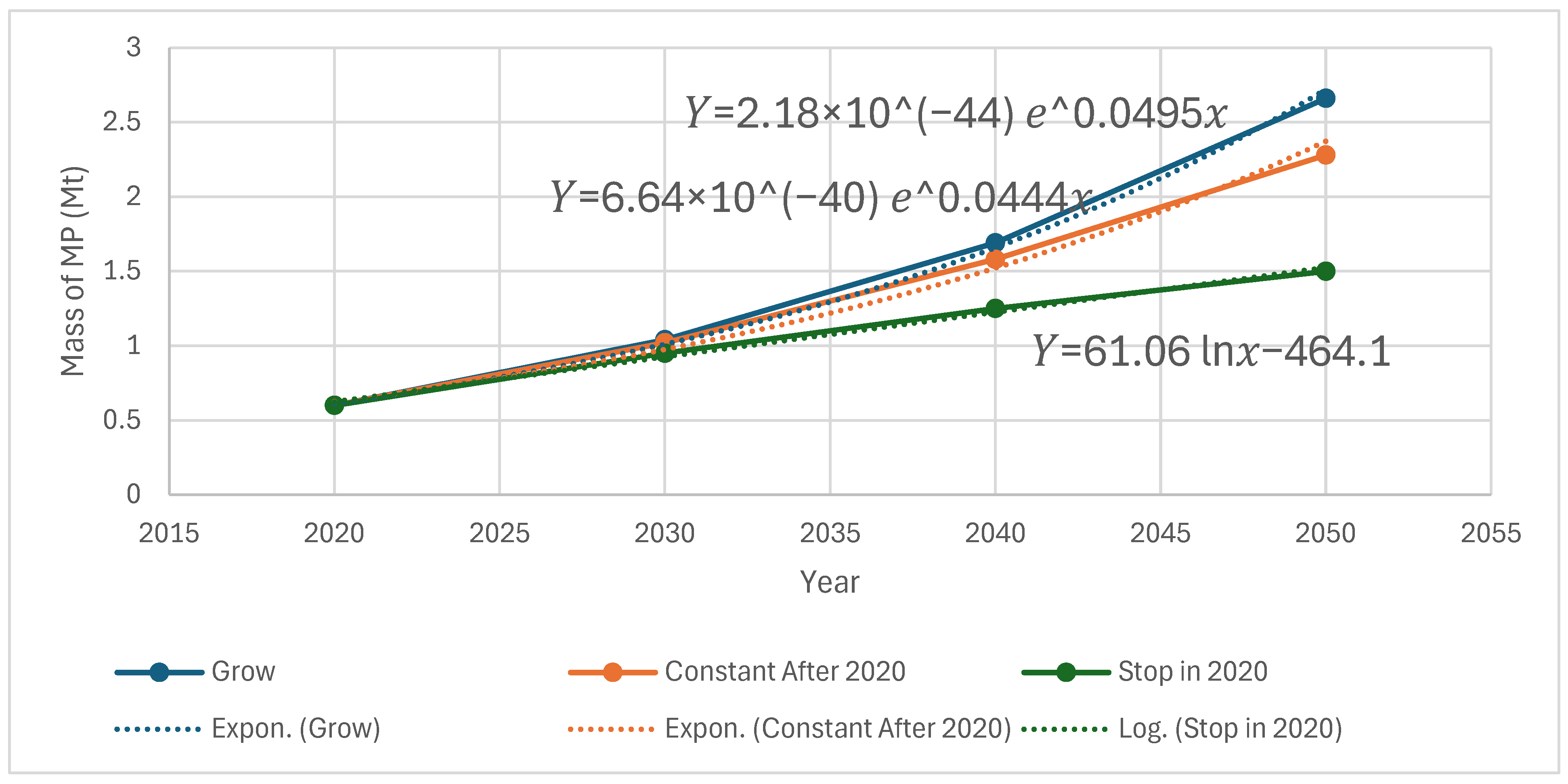
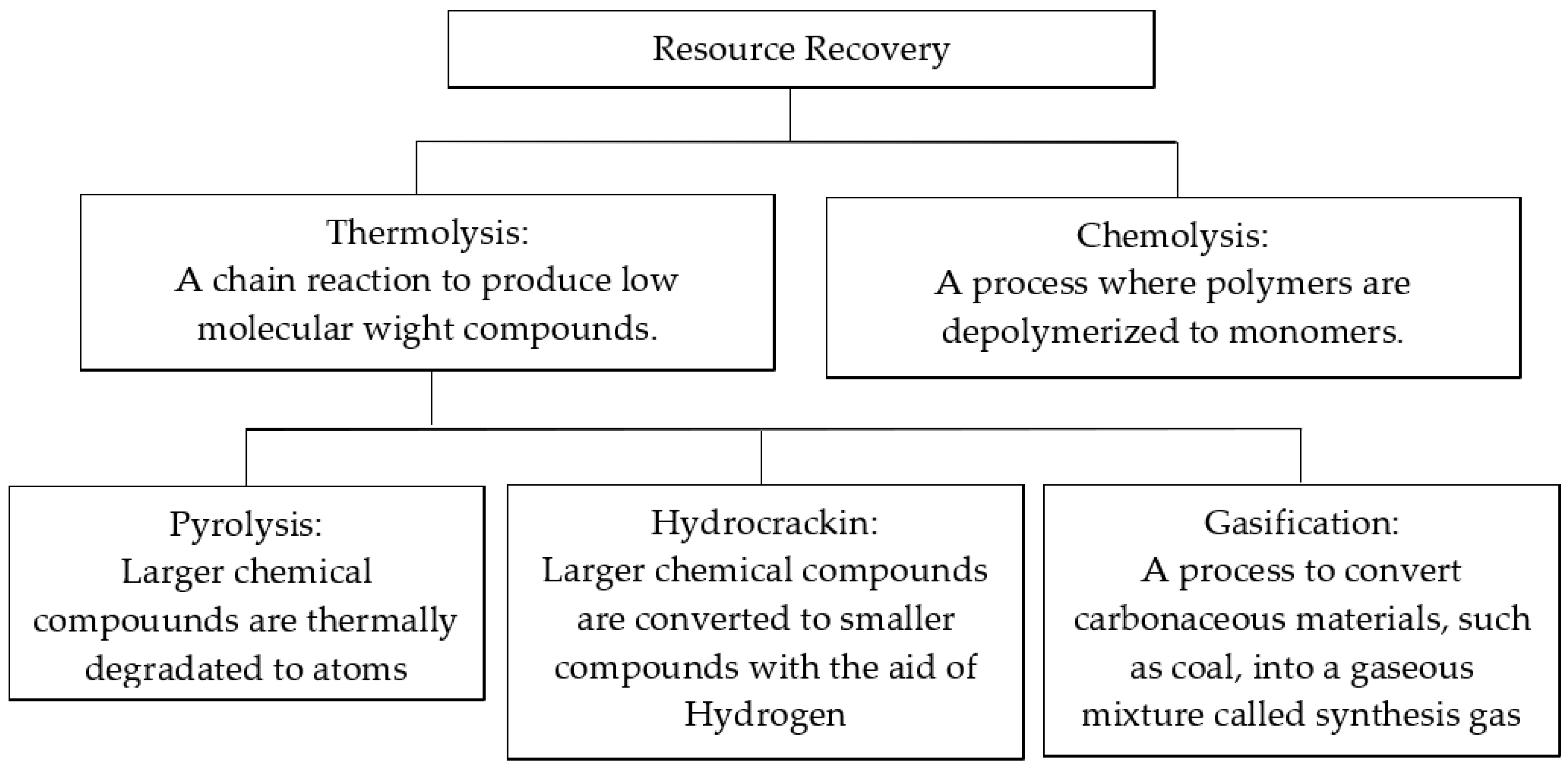
| Type | Source | Hydrophobic/Hydrophilic | Density |
|---|---|---|---|
| Polyethylene (PE) | Food wrap, shopping bags, detergent bottles, fuel | Hydrophobic | 0.857–0.975 g/cm3 |
| Polypropylene (PP) | Microbeads in personal care products, plastic bags, straws, bottles | Hydrophobic | 0.90–0.92 g/cm3 |
| Polystyrene (PS) | Floats, cups | Hydrophobic | 0.96–1.05 g/cm3 |
| Polyvinyl Chloride (PVC) | Electrical applications, pipes, windows | Hydrophobic | 1.38 g/cm3 |
| Nylon/Polyamides (PA) | Clothing | Hydrophilic | 1.14 g/cm3 |
| Cellulose Acetate (CA) | Cigarette filters | Hydrophobic | 1.3 g/mL |
| Polyester (PES) | Clothing | Hydrophobic | 1.38 g/cm3 |
| Frequency | Daily | Daily | Annually | Annually | Total for Both Routes | Total for Both Routes |
|---|---|---|---|---|---|---|
| Route of exposure | Consumed | Inhaled | Consumed | Inhaled | Daily | Annually |
| Male children | 113 | 110 | 41,106 | 40,225 | 223 | 81,331 |
| Male adults | 142 | 170 | 51,814 | 61,928 | 312 | 113,742 |
| Female children | 106 | 97 | 38,722 | 35,338 | 203 | 74,060 |
| Female adults | 126 | 132 | 46,013 | 48,270 | 258 | 94,283 |
| Total population | 487 | 509 | 177,655 | 185,761 | 996 | 363,416 |
| Body Part | Effect |
|---|---|
| Endocrine system |
|
| Immune system |
|
| Liver |
|
| Muscle |
|
| Olfactory sense |
|
| Gills |
|
| Circulatory system |
|
| Intestine |
|
| Gonads |
|
| Public Outreach and Communal Actions to Reduce MPs Within the Environment |
|---|
| Request protocols to establish recycling objectives |
| Request to set communal recycling objectives |
| Improve the collection methods and sorting |
| Manufacture a mechanism to fine the contamination of recycling stream |
| Request washing machine manufactures to capture MPs from effluent water |
| Request for nontoxic plastics |
| Request methods/rules to diminish plastics that enter water bodies via stormwater |
| Request mechanisms to lessen littering |
Disclaimer/Publisher’s Note: The statements, opinions and data contained in all publications are solely those of the individual author(s) and contributor(s) and not of MDPI and/or the editor(s). MDPI and/or the editor(s) disclaim responsibility for any injury to people or property resulting from any ideas, methods, instructions or products referred to in the content. |
© 2024 by the authors. Licensee MDPI, Basel, Switzerland. This article is an open access article distributed under the terms and conditions of the Creative Commons Attribution (CC BY) license (https://creativecommons.org/licenses/by/4.0/).
Share and Cite
Meegoda, J.N.; Pennock, W.H.; Brenckman, C.; Borgaonkar, A.D. Would the Oceans Become Toxic to Humanity Due to Use and Mismanagement of Plastics? Int. J. Environ. Res. Public Health 2025, 22, 17. https://doi.org/10.3390/ijerph22010017
Meegoda JN, Pennock WH, Brenckman C, Borgaonkar AD. Would the Oceans Become Toxic to Humanity Due to Use and Mismanagement of Plastics? International Journal of Environmental Research and Public Health. 2025; 22(1):17. https://doi.org/10.3390/ijerph22010017
Chicago/Turabian StyleMeegoda, Jay N., William H. Pennock, Christina Brenckman, and Ashish D. Borgaonkar. 2025. "Would the Oceans Become Toxic to Humanity Due to Use and Mismanagement of Plastics?" International Journal of Environmental Research and Public Health 22, no. 1: 17. https://doi.org/10.3390/ijerph22010017
APA StyleMeegoda, J. N., Pennock, W. H., Brenckman, C., & Borgaonkar, A. D. (2025). Would the Oceans Become Toxic to Humanity Due to Use and Mismanagement of Plastics? International Journal of Environmental Research and Public Health, 22(1), 17. https://doi.org/10.3390/ijerph22010017








